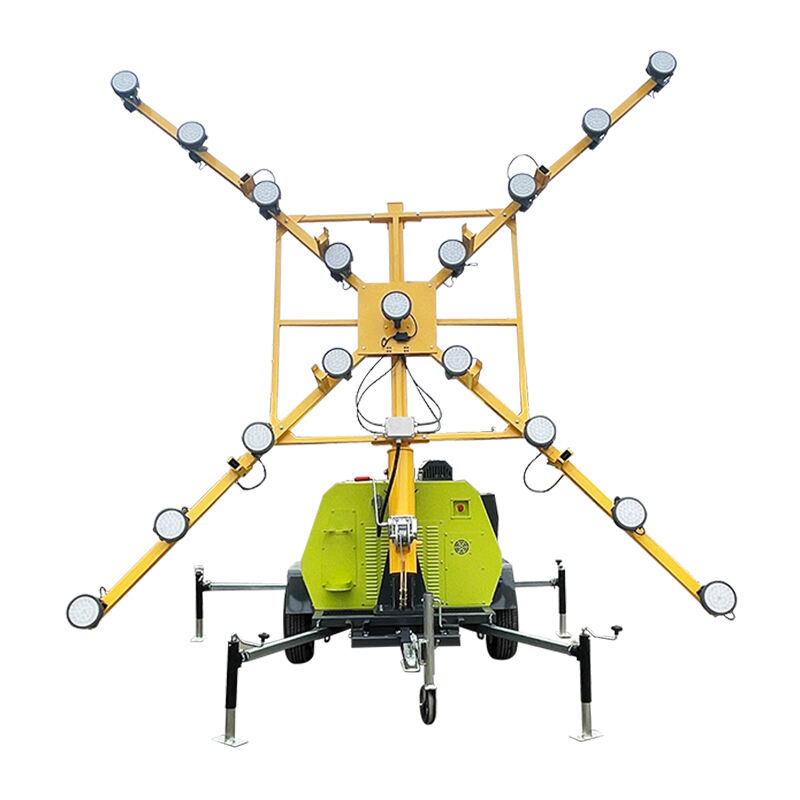4TN4000B Mobile Lighting Vehicle: Airport Runway Closure Sign & Safety Solution
4TN4000B Mobile Lighting Vehicle Overview
Trailer-Mounted Design for Rapid Deployment
The 4TN4000B storike’s trailer-mounted design facilitates swift setup and relocation, essential for minimizing downtime during runway operations. This configuration is particularly advantageous since it allows the mobile lighting vehicle to be effortlessly transported to various sites, ensuring operational readiness in emergencies—a critical aspect of airport safety. Features such as automatic leveling and stability further enhance its utility by ensuring the unit remains stable, even on uneven surfaces, reducing the risk of any operational delays due to equipment malfunction.
High-Intensity LED Runway Closure Signage
The 4TN4000B is equipped with high-intensity LED signage, ensuring maximum visibility crucial for indicating runway closures. These LEDs provide bright illumination while using less energy, a significant advantage over traditional lighting systems. Enhanced visibility is critical as studies suggest that it greatly mitigates the risk of runway incursions, thus boosting overall safety on the runway. By deploying such technology, the vehicle not only enhances operational efficiency but also contributes to a more environmentally sustainable approach to lighting.
Rugged Construction for All-Weather Operations
The rugged construction of the 4TN4000B is designed to withstand extreme weather conditions, thereby ensuring reliability throughout the year. The use of weatherproof materials and components guarantees that the mobile lighting unit maintains its operational integrity, irrespective of rain, snow, or high winds. Users have consistently outlined that such durability is indispensable for sustaining lighting services without interruption, highlighting its critical role in maintaining operational efficiency under challenging environmental conditions.
Integrated Power Supply & Mobility Features
An integrated power supply system in the 4TN4000B ensures continuous operation without interruptions, vital for consistent lighting during critical runway activities. The vehicle's mobility is enhanced with all-terrain tires and a user-friendly hitch mechanism, allowing for easy towing and maneuverability. According to aviation safety reports, a dependable power supply is paramount in sustaining consistent lighting, thus minimizing the risks associated with power failures during crucial operations. This combination of integrated power and versatile mobility makes the 4TN4000B an essential tool for airport safety and reliability.
Critical Role in Airport Runway Safety
Preventing Incursions During Closures
The mobile lighting vehicle plays a vital role in signaling closures effectively to prevent unauthorized access on the runway. Each year, many runway incursions occur because of inadequate signaling and poor visibility, highlighting the need for reliable lighting indicators. According to aviation safety reports, clear lighting significantly minimizes human error in emergency response scenarios, thereby improving overall safety standards. Enhanced visibility standards have been shown to substantially decrease the incidence of runway incursions, reinforcing the importance of rigorous lighting solutions for runway safety measures.
24/7 Visibility for Ground Crews & Pilots
This vehicle provides constant visibility for ground crews and pilots, whether during day or night operations, thus enhancing operational safety. Feedback from ground crew members often highlights the value of reliable lighting in facilitating safer vehicle navigation and personnel movement, especially during low visibility scenarios. According to regulatory compliance mandates, 24/7 operational lighting is essential in aviation contexts, ensuring safety standards are met continuously. This constant visibility helps in maintaining order and efficiency during critical airport operations.
Complementing Permanent Lighting Systems
The mobile lighting vehicle serves as a supplementary system to fixed airport lighting, offering flexibility and adaptability in diverse situations. Experts have repeatedly recommended this complementary approach during maintenance periods of permanent lighting systems to guarantee uninterrupted service. Case studies from various airports illustrate how temporary lighting solutions like the mobile lighting vehicle can balance workloads during peak operations without compromising safety. The flexibility of these supplementary systems ensures that airports remain fully functional, even under duress, maintaining safety and operational integrity throughout.
Key Technological Features
NVG-Compatible Lighting for Military Use
The inclusion of NVG-compatible lighting in mobile lighting vehicles is a significant technological advancement, particularly beneficial for military operations. This type of lighting is valuable because it aligns with military standards for nighttime operations, significantly enhancing safety in tactical environments. Military aviation experts consistently underscore the need for adaptable lighting solutions in airspaces shared by military and civilian aircraft. This adaptiveness ensures that operations can continue smoothly without compromising on safety, even during complex nighttime maneuverings.
Energy-Efficient Battery Operation
Energy-efficient battery operations in mobile lighting vehicles offer numerous advantages, chiefly through minimal power usage, thus prolonging the vehicle's deployment between charges. By reducing the carbon footprint with battery-powered systems, airports can fulfill environmentally conscious operational goals. Furthermore, research indicates that investing in energy-efficient systems can lead to substantial reductions in operational costs, ultimately benefiting airport budgets. This eco-friendly approach not only aligns with global sustainability efforts but also offers long-term financial benefits.
Wireless Remote Control Capabilities
Modern mobile lighting vehicles have embraced wireless remote control technology, which significantly enhances operational safety. This feature enables operators to manage lighting setups from a safe distance, reducing the need for crew to be present in potentially hazardous zones. As noted by aviation safety analysts, advancements in remote control technologies facilitate efficient management and improve operational responsiveness, particularly during emergencies. By streamlining operations and eliminating unnecessary risks, these systems play a crucial role in enhancing overall safety at airports.
Compliance with Aviation Standards
FAA Advisory Circular 150/5345-46D Compliance
Ensuring compliance with the FAA Advisory Circular 150/5345-46D is crucial for maintaining high operational standards in aviation. This circular outlines the technical specifications required for various types of airport lighting equipment. Meeting these rigorous guidelines not only improves the reliability of temporary lighting setups but also enhances safety in airport environments. For instance, studies of airport operations have shown that adherence to these standards reduces incidents during runway operations, thereby boosting operational efficiency and security.
ICAO Annex 14 Visibility Requirements
Compliance with ICAO Annex 14 visibility requirements is pivotal for international airports aiming to uphold global operational standards. These regulations ensure that airport lighting systems meet both national and international safety norms, which are critical in managing aviation safety risks. Historical analyses highlight that failing to meet these requirements can significantly increase the risk of accidents, underscoring the necessity for strict adherence.
International Airport Lighting Norms
Adhering to international airport lighting norms is essential for ensuring compatibility and safety across different international locations. By complying with these norms, airports can enhance interoperability and foster cooperation by sharing resources and expertise. Moreover, continuous updates to these norms reflect technological advancements and evolving safety measures, thereby ensuring that airport lighting systems remain at the forefront of innovation and safety standards.
Operational Advantages & Use Cases
Emergency Runway Closure Scenarios
During emergency situations, the deployment of mobile lighting vehicles is crucial for ensuring immediate safety and sufficient signaling on runways. In real-world scenarios at airports, rapid response times have been critical in minimizing potential risks associated with unforeseen closures. For instance, airports that have utilized mobile lighting in emergencies report lower incident rates due to the quick illumination of the runway areas. Coordinating with first responders is essential in these situations, and features like fast setup and mobility of the lighting vehicles facilitate swift deployment to necessary locations.
Temporary Taxiway Maintenance Solutions
Maintaining taxiways can often disrupt airport operations; however, mobile lighting vehicles provide the necessary illumination to reduce such disruptions. By ensuring well-lit environments, these vehicles help in maintaining operations smoothly even during necessary maintenance interventions. Reports from the industry underline the cost-efficiency of using mobile lighting solutions, as they significantly cut down on downtime, thereby saving costs and sustaining normal airport function. These solutions have shown positive outcomes by enabling uninterrupted work during essential taxiway maintenance.
Multi-Airport Fleet Deployment Strategies
Managing a fleet of mobile lighting vehicles across multiple airports optimizes operational efficiency and enhances response times. Centralized management systems streamline the distribution of these assets based on real-time needs and demands, ensuring that airports are equipped with adequate lighting promptly. Studies and statistics indicate that coordinated fleet management approaches significantly enhance airport safety and lighting availability, ultimately reducing operational bottlenecks and improving overall safety standards. This strategic deployment supports airports in maintaining continuity in lighting solutions across different locations.
 EN
EN
 AR
AR CS
CS DA
DA NL
NL FI
FI FR
FR DE
DE IT
IT NO
NO KO
KO PL
PL PT
PT RO
RO RU
RU ES
ES SV
SV TL
TL ID
ID LV
LV SR
SR SK
SK SL
SL VI
VI SQ
SQ ET
ET TH
TH TR
TR AF
AF MS
MS GA
GA HY
HY KA
KA BS
BS LA
LA MN
MN MY
MY KK
KK UZ
UZ KY
KY


